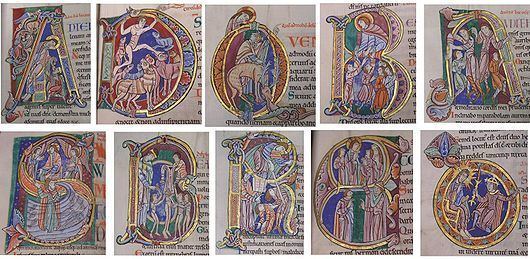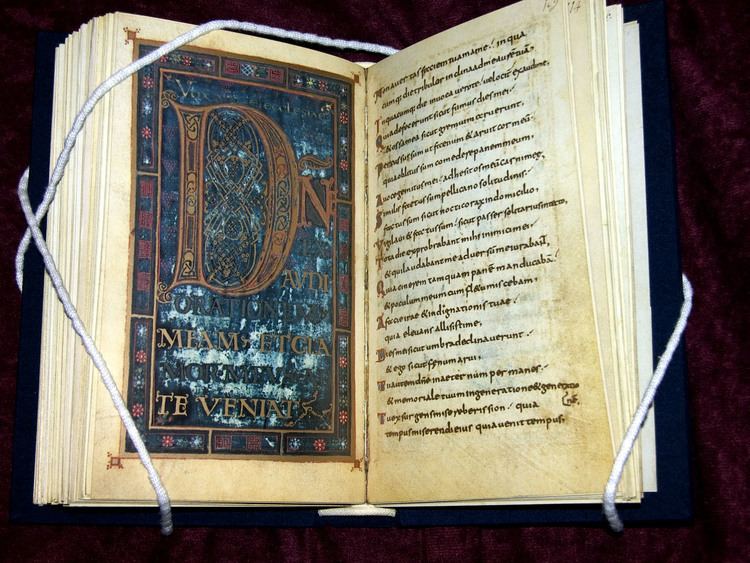 | ||
Psalm 63 psalter 163 satisfaction in god
A psalter is a volume containing the Book of Psalms, often with other devotional material bound in as well, such as a liturgical calendar and litany of the Saints. Until the later medieval emergence of the book of hours, psalters were the books most widely owned by wealthy lay persons and were commonly used for learning to read. Many Psalters were richly illuminated and they include some of the most spectacular surviving examples of medieval book art.
Contents
- Psalm 63 psalter 163 satisfaction in god
- Psalm 1 genevan psalter 1539
- Western Christianity
- Eastern Christianity
- Manuscripts
- Early Medieval
- High Medieval
- Late Medieval
- Early modern Tudor period
- Printed editions
- Incunabula
- Early modern editions
- Modern editions
- References

The English term (Old English psaltere, saltere) is from Church Latin psalterium, which is simply the name of the Book of Psalms (in secular Latin, it is the term for a stringed instrument, from Greek ψαλτήριον psalterion). The Book of Psalms contains the bulk of the Divine Office of the Roman Catholic Church. The other books associated with it were the Lectionary, the Antiphonary, and Responsoriale, and the Hymnary. In Late Modern English, psalter has mostly ceased to refer to the Book of Psalms (as the text of a book of the Bible) and mostly refers to the dedicated physical volumes containing this text.

Psalm 1 genevan psalter 1539
Western Christianity

Dedicated psalters, as distinct from copies of the Psalms in other formats, e.g. as part of a full edition of the Old Testament, were first developed in the Latin West in the 6th century in Ireland and from about 700 also on the continent.

The extensively illustrated Utrecht Psalter is one of the most important surviving Carolingian manuscripts and exercised a major influence on the later development of Anglo-Saxon art. In the Middle Ages psalters were among the most popular types of illuminated manuscripts, rivaled only by the Gospel Books, from which they gradually took over as the type of manuscript chosen for lavish illumination. From the late 11th century onwards they became particularly widespread - Psalms were recited by the clergy at various points in the liturgy, so psalters were a key part of the liturgical equipment in major churches.

Various different schemes existed for the arrangement of the Psalms into groups (see Latin Psalters). As well as the 150 Psalms, medieval psalters often included a calendar, a litany of saints, canticles from the Old and New Testaments, and other devotional texts. The selection of saints mentioned in the calendar and litany varied greatly and can often give clues as to the original ownership of the manuscript, since monasteries and private patrons alike would choose those saints that had particular significance for them.

Many psalters were lavishly illuminated with full-page miniatures as well as decorated initials. Of the initials the most important is normally the so-called "Beatus initial", based on the "B" of the words Beatus vir... ("Blessed is the man...") at the start of Psalm 1. This was usually given the most elaborate decoration in an illuminated psalter, often taking a whole page for the initial letter or first two words. Historiated initials or full-page illuminations were also used to mark the beginnings of the three major divisions of the Psalms, or the various daily readings, and may have helped users navigate to the relevant part of the text (medieval books almost never had page numbers). Many psalters, particularly from the 12th century onwards, included a richly decorated "prefatory cycle" - a series of full-page illuminations preceding the Psalms, usually illustrating the Passion story, though some also featuring Old Testament narratives. Such images helped to enhance the book's status, and also served as aids to contemplation in the practice of personal devotions.
The psalter is also a part of either the Horologion or the breviary, used to say the Liturgy of the Hours in the Eastern and Western Christian worlds respectively.
Eastern Christianity
Non-illuminated psalters written in Coptic include some of the earliest surviving codices (bound books) altogether; the earliest Coptic psalter predates the earliest Western (Irish) one by more than a century. The Mudil Psalter, the oldest complete Coptic psalter, dates to the 5th century. It was found in the Al-Mudil Coptic cemetery in a small town near Beni Suef, Egypt. The codex was in the grave of a young girl, open, with her head resting on it. Scholar John Gee has argued that this represents a cultural continuation of the ancient Egyptian tradition of placing the Book of the Dead in tombs and sarcophagi.
The Pahlavi Psalter is a fragment of a Middle Persian translation of a Syriac version of the Book of Psalms, dated to the 6th or 7th century. In Eastern Christianity (Eastern Orthodox, and in modern times also Byzantine Catholic), the Book of Psalms for liturgical purposes is divided into 20 kathismata or "sittings", for reading at Vespers and Matins. Kathisma means sitting, since the people normally sit during the reading of the psalms. Each kathisma is divided into three stases, from stasis, to stand, because each stasis ends with Glory to the Father…, at which everyone stands. The reading of the kathismata are so arranged that the entire psalter is read through in the course of a week (during Great Lent it is read through twice in a week). During Bright Week (Easter Week) there is no reading from the Psalms. Orthodox psalters usually also contain the Biblical canticles, which are read at the canon of Matins during Great Lent.
The established Orthodox tradition of Christian burial has included reading the Psalms in the church throughout the vigil, where the deceased remains the night before the funeral (a reflection of the vigil of Holy Friday). Some Orthodox psalters also contain special prayers for the departed for this purpose. While the full tradition is showing signs of diminishing in practice, the psalter is still sometimes used during a wake.
Manuscripts
See also Category:Illuminated psalters
Early Medieval
High Medieval
Late Medieval
Early modern / Tudor period
Printed editions
See also Category:Psalters
